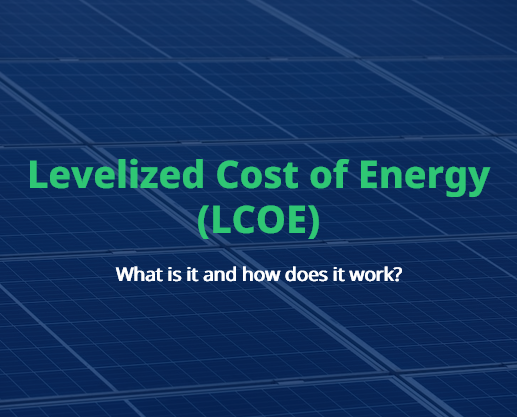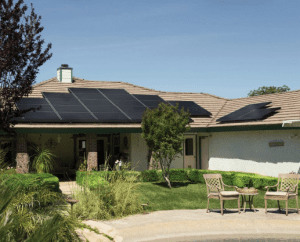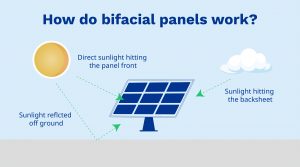What is levelized cost of energy and how does it work?
Levelized cost of energy (LCOE), also known as levelized cost of electricity, is a figure used to measure the lifetime cost of energy production by a given system. The LCOE helps us to easily compare the cost of energy of various different forms of energy production, such as wind, natural gas, and solar.
As such, it is used by a range of different people from engineers to homeowners, business owners, and more to quickly compare the economic value and viability of different systems before making an investment.
In this article, with a focus on solar energy, we look at what the LCOE means, why it’s so useful, and how to calculate the LCOE. Read on to learn all about the LCOE and the impact it can have on your energy choices.
What is the levelized cost of energy?
The LCOE is a figure used to measure the average cost of generating one kilowatt hour (kWh) of electricity over the lifetime of a generating asset. To do this, the LCOE takes into account the costs associated with a system, including installation, operation, maintenance, and fuel.
Because it simplifies all costs relative to the energy produced into a single figure, the LCOE is a very straightforward and easily understandable way to compare different energy production systems.
Please note that whether decommissioning costs you money or lets you recuperate some of the residual value of your system depends on where you live, and so isn’t included in this simplified formula. Equally, the discount rate you receive depends on where you live, so is similarly excluded from the formula.
The LCOE is commonly used in the context of solar panels as a way to determine whether a planned photovoltaic (PV) system is worth the investment. Without looking at the LCOE, it would be very difficult to know if an investment in solar would be cost-effective relative to other forms of energy, so it is generally a vital part of solar planning.
At Hoymiles, we regularly use the LCOE to rate our products, such as our microinverter line.
Why is the LCOE important?
While the LCOE has been used for a long time by installers, engineers, and businesses, it has also become increasingly commonly used by the public in recent years. This is a result of homeowners turning away from traditional forms of energy production (i.e., paying a utility company for electricity from the grid). This is partially driven by an increase in the cost of traditional energy, but also by the increased focus on, and greater accessibility of, renewable energy sources such as solar.
Energy production systems are technologically complex, and the average person may find it difficult to understand the calculations and figures that are often involved, as well as the various lifetime costs that come with paying for a new system. The LCOE provides a concise “snapshot” of real-world energy costs, enabling anybody to quickly and easily compare different forms of energy production and whether they are worth the investment. The LCOE can also help you to make a clear comparison between the financial return of different solar PV set-ups.
Beyond its use by the public, the LCOE plays an influential role in energy policy around the world. Due to its simplicity, many policymakers use the LCOE to compare various forms of energy production and make decisions about which to incentivize/subsidize. In fact, the low LCOE of solar is an important part of why many governments choose to offer solar subsidies, such as those offered across the US and in other countries around the world.
However, it’s important to remember that, as a single figure, the LCOE doesn’t provide a full picture of everything influencing an investment decision. For example, many people want to switch energy sources as a way to reduce their carbon footprint. Additionally, some may be more concerned with energy independence and not having to rely on the grid for energy. In this case, traditional energy sources (which may well have a lower LCOE than some alternatives) may be undesirable, and options like a solar microgrid may be preferable.
LCOE meaning and LCOE formula
The LCOE of a given energy production system represents the real-world cost of energy it produces over its lifetime. To calculate the LCOE, we need to take the present value of all costs associated with generating 1 kWh of electricity by a given system and divide it by the total number of kilowatt hours generated over the system’s lifetime.
The factors used to calculate lifetime costs are capital costs, operating and maintenance costs, and fuel costs.
A simplified LCOE formula is:
LCOE = total lifetime costs of energy production system / total energy produced over system’s lifetime
Minimizing the LCOE of solar with microinverters
Solar is a hugely popular and reliable form of renewable energy, and one of the forms of alternative energy most widely adopted by both the public and energy companies worldwide. As climate change concerns grow and the price of traditional energy sources continues to rise, solar is set to make an even greater contribution to the world’s energy needs.
However, while solar can be an excellent and cost-effective energy source, minimizing the LCOE is always going to be a priority for anybody looking to invest in a solar set-up. One way to do this is to use a microinverter-based system. Microinverters lower the LCOE in several key ways:
- They are more efficient than traditional inverters, so more of the energy produced by your PV array will be converted into usable electricity.
- They have a longer lifespan than most traditional inverters, spreading the investment cost over a longer period and lowering the LCOE of your system. Many microinverters have an expected lifespan of 35 years, although when you consider the overall performance of your system’s components, an expected lifespan of 25 years is standard.
- They are easier to install than traditional inverters, so you’ll save on installation costs.
Solar PV: LCOE formula calculation example
– Let’s say a household in Brazil is considering a 6 kW microinverter solar PV system with an upfront cost of $6,400 and an expected lifetime of 25 years.
– For example purposes, let’s say the planned 6 kW PV (3 microinverters of 2 kW with 12 x 600W panels) system will receive an average of five hours of peak sunlight every day. 6 kW × 5h × 365d = 10,950 kWh of electricity per year (10.95 MWh).
– Considering the fact that modules degrade every year, the power generated over 25 years would be less than simply multiplying 10,950 kWh and 25 years. A reasonable estimate for the total power generated would be 203,670 kWh, or 204 MWh.
– There are effectively no operating and maintenance costs (this is one of the major benefits of a microinverter system).
– There are no fuel costs.
– The LCOE for this solar PV system would be:
– The local electricity price is about $0.212/kWh, or $212/MWh
– In this example, the cost of solar energy would be around 15% compared with using energy from the grid—a huge saving that makes solar the economical choice.




